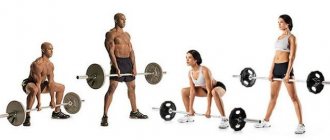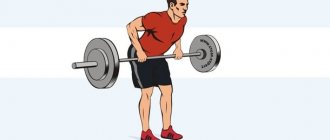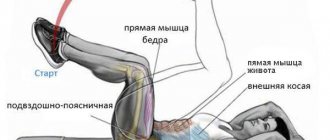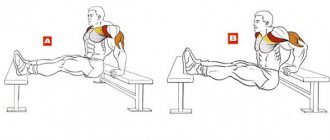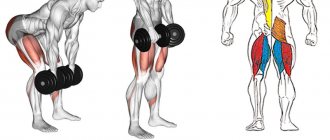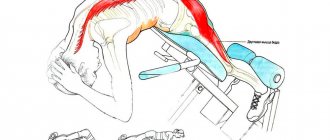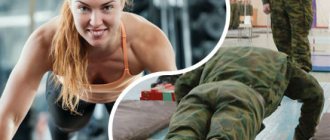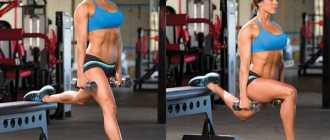Home / Exercises for the buttocks / One-leg glute bridge
Today we will look at a very cool and effective exercise (which I can recommend) for all girls/women - single leg glute bridge. I will reveal all its subtleties, secrets and nuances of implementation.
The gluteal bridge is a lying pelvic lift (different names for the same exercise).
This exercise works great on the buttocks and back of the thighs (hamstrings).
The peculiarity of this exercise is that it is performed lying on the floor, that is, the load on the spine is very negligible, this is not squats and others)) that is, the exercise is very safe and comfortable.
Also, the exercise does not require any additional equipment and can easily be performed at home, even by teenagers.
Electromyostimulation (EMG) indicators (for those who don’t know, this is an indicator of the intensity of muscle contraction, on the basis of which a conclusion is made about which exercise is effective/less effective, etc.):
- on the buttocks - 142.0
- for the biceps of the thighs - 130.0
These EMG indicators relate to work on two legs - on the floor. Not on one leg (no data on one leg).
In any case, the results are very encouraging - these are very decent indicators, to be honest, this EMG exercise showed the highest results for the buttocks, think about how really cool the exercise is!
Even the same squats with a barbell on the shoulders showed the buttocks - 58.0)) draw your own conclusions.
We can say that the lying pelvic lift (glute bridge) is the best exercise for the buttocks. This may shock someone, I understand)) later I will give further explanations on this matter and reveal the disadvantage of this exercise.
The hamstring exercise is also a very cool exercise, the performance is powerful, only the deadlift (Romanian) and deadlift are higher, and so on - well, it’s just a bomb exercise, but unfortunately, it only has 1 minus!!!!
Its only drawback is that it is an isolating exercise (not a basic one).
This means that it should be done only after basic basic (multi-joint) exercises:
- "Barbell Squats"
- "Leg press"
- "Lunges"
- "Deadlift"
This is the only way it will have maximum use (effect), and only this way will you get maximum benefit from it?
In itself - even despite the fact that according to EMG - it has unrealistically cool indicators - it is the best, it will not be able to give you that cool ass that basic strength exercises, such as squats, will give you. Understand?
This is information that has already been proven by many years of experience - well, that’s it, I’m just telling it as it is.
It is isolating - it is not strength - it cannot give the mass, those gains that the same squat will give. However! This exercise simply must be used, but only at the end of the workout - after the basic ones.
No, of course, if the question is whether to do just this or not to do it, it’s better to do at least something than to do nothing at all, but believe me, after the basics this exercise will work a hundred thousand times better, so see for yourself...
About the muscle ensemble
The glute bridge is a multi-joint functional movement that helps stretch the hips and activate the glutes. Pelvic lifts, which make the buttocks slender and toned, also have a tonic function that helps relieve and even prevent lumbar pain. The main muscles that work when performing the gluteal bridge are the small, medium and large muscles of the buttocks. Secondary are: the anterior and posterior muscles of the thighs, core, calves, spinal extensors.
The picture will help you get acquainted with the atlas of working muscles in more detail:
Benefits of the gluteal bridge
This exercise should not be regarded solely from the point of view of aesthetic correction of the shape and size of the buttocks. It brings much more benefits, which are as follows:
- distribution and receipt of correct and uniform load on the lumbar region;
- the development of strength and endurance of the gluteal muscles affects walking and running, which begin to be much easier;
- Being part of the center, since the muscles of the buttocks are located precisely in the middle of the body and are partially responsible for motor functions, they need training and development in order to strengthen the lower back, stabilize the muscles of the central part and prevent the occurrence of back pain.
Considering all of the above, performing a gluteal bridge should not only give the “fifth point” a beautiful shape and roundness, but also to improve athletic performance, as well as the health of the lumbar region.
How is the glute bridge different from other exercises?
The gluteal muscle is the largest group in the human body, consisting of small, medium, large muscles. Their functions, according to Stuart McGill in an interview with Strength and Conditioning Journal, are directly related to the pelvis in terms of biomechanical and anatomical effects, which makes this muscle group the main force generator.
From this characteristic of the gluteal muscles it follows that any extension carried out in the hip joint is a movement that involves a large force, required in many sports disciplines. Without it, it is impossible to swing a baseball bat, perform gymnastic and athletics movements, hit a ball, throw a basketball and jump. Each such movement requires hip extension at the hip joints.
The second most popular goal among women in the gym is to pump up a firm butt.
Can you imagine how often we get questions like: “what exercises for the buttocks, besides lunges and squats, can you do”?
Broad Bone answers: there are many exercises for training the buttocks, but it is important to understand that they often duplicate each other and there will be little benefit from doing them.
But the glute bridge (lying up butt lift) is a completely different matter.
About the advantages of pelvic lifts
Compared to squats, pelvic lifts do not put pressure on the lower back.
In addition, the training allows you to:
tighten the muscles of the buttocks without squats;
- strengthen the abs;
- perform training with your own and free weight;
- increase and strengthen the strength of the muscles that are involved in jumping and running;
- improve blood circulation in the pelvic organs (increase tone);
- increase libido;
- regulate weight by burning a large number of calories;
- train without additional equipment.
We recommend:
- How to do exercises for hips and buttocks correctly
- What does it take to get on the bridge?
- How to pump up your buttocks at home: exercise program
Benefits of a one-leg bridge
The exercise will include all three bundles of the buttocks: the middle, small and large gluteus. Plus, the back of the thigh and lower back are being finalized. Due to this, the load in the exercise increases and makes it more intense.
The bridge builds functionality and aesthetics of form. It is suitable for desk-bound sedentary jobs because it improves hip mobility and lower back strength. A sedentary lifestyle actually weakens the gluteal muscles and can lead to back problems.
The single leg bridge exercises the muscles sufficiently without any weight. But if the goal is strength and muscle growth. You can gradually add weight - dumbbells or barbells on your hips are usually easiest and most comfortable.
Read : Glute bridge exercise in Smith
Make single leg bridges part of your workout.
Start doing single-leg glute bridges two to three times a week without weights. As you develop strength and quality in the movement, you can begin to gain weight. At the same time, reduce the number of exercises to once a week to improve the shape of the gluteal muscles and give them time to recover.
To make it more difficult, you can do a super set. Combine this exercise with counter movements, a superman style will do, or perform all three sets separately along with other leg and glute exercises.
Want to try a full workout that includes glute bridges?
Try this set of exercises:
- 20×3 Standing on all fours, alternate swings to the side and back with a bent leg.
- 20×3 Glute bridge lying on the floor
- 15×3 Jump Squats
Read : Training programs for butt enlargement
Is execution technique important?
The answer is yes. Even in such a simple exercise as the gluteal bridge, where it seems impossible to “deviate from the course,” you cannot do without it. Pelvic lifts in a step-by-step version are presented below.
Step zero, or preparatory. Lie on a mat placed on the floor, bend your knees, placing your feet firmly on the floor. Hands lie on the stomach or along the body. That's all you need to know about the starting position.
Step one. As you inhale, squeeze your buttocks and raise your hips to the point where your body from your knees to your shoulders is in one line. Stay in the top position for a couple of counts, squeezing your gluteal muscles even tighter, exhale and return to the starting position for the next repetitions.
It all looks like the picture below:
How to do a glute bridge on one leg
Execution technique
- Initial position . Lying on your back with your knees bent, feet shoulder-width apart and 30–40 cm from your buttocks. Lift your right leg so that it is straight in the air at hip level.
- Keeping your shoulder blades flat on the floor, tuck your buttocks by pushing through your left heel. Lift your hips off the ground until your knee, hips, and shoulders form a straight line.
- Keep the case on at all times. Pause at the top, squeezing your buttocks for a second or two. Then lower back down to the starting position. Complete the reps, then switch legs.
The single leg glute bridge targets all three gluteal muscles – the gluteus maximus, gluteus medius and minimus.
Reps/sets for best results: Without weights, aim for three sets of 15-20 reps. If you are adding weight, reduce it to 12 reps. Rest for 30 seconds between each set.
Read : Gluteal bridge. 8 options
Technique Tips : Be sure to fully extend your hips at the top of the movement. Push through your heel, lifting your pelvis up and squeezing your glutes. Besides! It is important to note that the contraction and pause at the top of this movement is critical to fully recruiting the muscle fibers.
Learning the intricacies of the exercise
The maximum benefit comes from the gluteal bridge, provided that the following recommendations are followed:
- the angle between the back surface and the lower leg should not be too small or large (the legs should be in a comfortable position);
- do not lift your feet off the floor during lifting;
- push to move upward using heels;
- lift the body off the floor as high as possible;
- peak contraction is carried out at the top point, where it is delayed for a couple of counts;
- you cannot rest at the lowest point;
- the weight of the burden is added gradually as fitness increases;
- do not pinch the nerve endings, do not rest your neck on the floor;
- It is recommended to perform 3 sets of 10 repetitions.
- Is a glute bridge effective for your butt?
If you believe American scientists (and there is no reason not to do this), who have conducted more than one study, then the exercise is very effective for working out the buttocks. The highest levels of electrical activity were recorded while performing a gluteal bridge from a bench. Next, the “places” were divided into the version with weights (barbell, plates) and with support on one of the legs.
That is why the gluteal bridge should be included in the training program, which is aimed at working out the female “center of the universe”.
Video: Glute bridge
There are also many variations in this exercise:
- Single Leg Elevated Glute Bridge: Perform the same movement as above, but with one leg on the floor and one leg on a Bosu ball or bench.
- Single-legged glute bridge: Perform the same movement as a single-legged glute bridge, but with a barbell, dumbbell, or kettlebell. Place them over the center of your hips.
- Single Leg Bridge with Band: Perform the exercise the same way, but with a band wrapped around your thighs.
- One-legged bench bridge: Lie with your shoulder blades on a flat bench, with one leg on the floor and the other straight out at hip level. Lower your hips, then drive up through your heel to lift your hips to the height of the bench, squeezing your glutes. Then, lower down and repeat.
Recommendations
- This version of the gluteal bridge is ideal for a beginner - there is no need to assemble a barbell, and somehow experiment with soft pads, look for mats, spotters, etc. Meanwhile, the weight of the weight can be set much more than when working with a dumbbell, pancake, weight and other microweights that beginners love to use;
- Those who continue are recommended to work in the simulator when it is not possible to train hard, or there is a desire to do pumping training;
- If it is not convenient to take the starting position, the shin is much shorter than the thigh and the amplitude is minimal, you should use a step platform and place it under your feet, or place pancakes under your feet
Working with weights (barbell)
The gluteal bridge, as has already become clear from what was described above, is a simple and at the same time highly effective exercise. It has both advantages and disadvantages. In general, the latter relate only to options for performing movements.
So, for example, when doing pelvic lifts from a lying position on the floor, athletes do not have the opportunity to lower the pelvis deeper. Consequently, the muscles will not stretch to their maximum limit. This may delay the long-awaited effect. At the same time, at the upper maximum point they can tense more intensely. This is due to the fact that the force of gravity exerts a counterbalance to the body. This is especially noticeable when the exercise is performed with weights (barbell, plate).
When working with a barbell, you should also consider a couple of recommendations regarding the correct technique. First, hold the barbell with your palms facing down. This will allow you to push the bar down as you raise your glutes and keep it in the same position as you lower. Secondly, you can use two options for reproducing physical movements. As in the classic scheme, you can do a bridge with a barbell:
- placing your feet on the floor with your knees bent and the bar of the barbell located in the area of the pubic joint, resting your upper back on the bench;
- with feet on a bench, lying with shoulder blades on the floor and weight in the area of the pubic symphysis.
Exercises performed on a bench (gluteal bridge) are more effective. They allow you to achieve greater depth and amplitude, which will give results in a shorter time.
To summarize, we can safely say that the gluteal bridge is a very simple exercise that is more effective than many others and helps to pump up and make the buttocks and butt more elastic. In addition, to perform it it is not necessary to have special sports equipment or exercise equipment - it is quite possible to reproduce the physical movements described in the article and shown in the photo at home. Considering the versatility, practicality of the exercise and the ability to get rid of extra pounds with its help, it makes it almost irreplaceable.
Main nuances
Despite the simplicity of performing the gluteal bridge, this exercise has its own characteristics that allow you to increase efficiency:
- To increase efficiency and do deeper work, carry out actions from a support. By leaning on a stand or bench, you will be able to lower your pelvis lower. Consequently, it will take more effort to lift it with your buttocks and, as a result, you will be able to achieve results in a shorter time;
- Breathing technique must be observed (lifting while inhaling, lowering while exhaling);
- When using additional weight, the load must be calculated correctly. The weight should be such that you can easily perform up to 10 repetitions with it for each of 2-3 approaches.
As for calculating weights, experienced trainers have developed more or less approximate indicators. They depend on the athlete’s level of training and his gender:
- girls are allowed to do 2-3 approaches with 10-20 repetitions in each and a weight of up to 500 g;
- guys can perform the same 2-3 sets of 10-20 repetitions with weights up to 10 kg.
Since these actions are not basic, they are best performed in conjunction with the main exercises of the training program. In this case, you will be provided with a more effective result.
Adviсe
- Carefully monitor your breathing: exhale when raising your buttocks, inhale when lowering.
- Start your workout with a warm-up set of 20-25 reps without weight.
- Choose an additional weight so that you can do 10-15 repetitions, while the last of them are difficult for you.
- Don't forget about the preliminary warm-up!
The glute bridge is a great exercise that will help tone your glutes without bulking up your quads. Include it in your workouts at least once a week and you will soon notice the first positive results!
Barbell squat or glute bridge? A woman's difficult choice
Brazilian researchers compared the effects of back squats and glute bridges on strength and muscle growth in well-trained women.
When it comes to increasing muscle size and strength, there's nothing better than weight training. Its results depend on many parameters, such as intensity, rest intervals, range of motion, muscle activity, time under tension, choice and order of exercises. And it is very important to choose these parameters correctly. The American College of Sports Medicine recommends a combination of single-joint and multi-joint exercises. Brazilian researchers led by Paolo Gentil, a researcher at the Federal University of Goiás, do not support this point of view. They note that incorporating single-joint exercises into multi-joint training does not improve strength and muscle size in untrained men and women.
Brazilian and Italian researchers compared different types of exercise and concluded that resistance training consisting only of multi-joint exercises improved muscle strength and cardiorespiratory fitness better than single-joint exercises alone. There is no difference in body composition. Somewhat earlier, Brazilian scientists showed that in untrained men performing single-joint or multi-joint exercises, the strength and volume of the elbow flexors increased equally. However, this study only looked at hands. And since the upper and lower extremities respond differently to resistance training, you need to figure out which exercises will be most effective for the muscles of the lower body, including the quadriceps and gluteus maximus.
The most effective exercise for the gluteus maximus muscle is the gluteal bridge. Previous research has shown that the glute bridge maximizes hip extensor activation, strength, and size. This is a single joint exercise. However, all studies compared the effectiveness of single-joint and multi-joint exercises (front squats, back squats, and lunges) using electromyography. However, high electromyographic indicators do not necessarily indicate the number of motor units involved and do not allow one to judge hypertrophic potential.
Another important point is that the only study comparing the effects of single-joint and multi-joint exercises on muscle hypertrophy was performed on men. However, resistance training affects recovery, fatigue, and muscle activation differently in men and women. Therefore, special studies need to be conducted for women. This is what Brazilian scientists did. They compared the effects of back squats (a multi-joint exercise) and glute bridges (a single-joint exercise) on strength and muscle growth in well-trained women.
Twenty-two participants with at least three years of training experience were randomly assigned to do the back squat (BS) or hip thrust (HT) for 12 weeks (Table 1).
Participants in each group performed six sets per week.
Before and after the training period, the researchers measured the thickness of the participants' quadriceps and gluteus maximus muscles and determined one repetition maximum (1RM) for each exercise. Muscle thickness was determined before the start of the experiment and 5 - 7 days after the last training session so that swelling did not affect the results.
The participants' diet was not monitored, but they were asked to maintain their normal diet and regularly checked for any drastic changes, such as the use of energy supplements, changes in the balance of proteins and carbohydrates, or the transition to vegetarianism.
To determine 1 MP, participants performed a back squat or a barbell glute bridge. The warm-up consisted of 8 repetitions with a comfortable weight, which was determined by the participants themselves, followed by a five-minute rest. Then, based on the participants’ results, the initial load was determined. If participants were unable to perform one repetition or performed more than one, the load was adjusted by 1 kg. There was a 5-minute break between trials, and no participant required more than three trials to reach 1 MP.
The thickness of the quadriceps femoris and gluteus maximus muscles was determined before and after a 12-week training period. The thickness of the quadriceps femoris muscle was determined at the midpoint of the distance between the lateral femoral condyle and the greater trochanter. Although measurements at this point primarily involve the rectus femoris and vastus intermedius muscles, the researchers decided to use it to determine the thickness of the quadriceps femoris muscle. This measure was included in the study because the glute bridge activates this muscle in the same way as the front squat.
The thickness of the gluteus maximus muscle was determined at the midpoint of the distance between the sacral vertebra and the greater trochanter. All measurements were performed at the same time by a specialist who did not know how the participants were divided into groups. During this time, participants were asked not to participate in other workouts and to moderate physical activity. An ultrasonic device with a frequency of 7.5 MHz was used for measurements.
Participants trained once a week, with one group doing six sets of back squats and the other doing six sets of glute bridges. To perform the bridge, the participant sat on the floor, resting her upper back on a soft bench. The bar was located symmetrically at the crease of the hips just above the pelvis. The participants lifted the barbell so that the force came from the hips, and not from the lumbar spine. The movement began when the buttocks lifted slightly from the ground and ended when the hips were fully extended. The back squat was performed with the knees bent completely, approximately 140 degrees. Observers were present at the session, at least one for every five participants.
The training protocol was based on nonlinear periodization. At weeks 1, 5, and 9, participants performed 12 to 15 repetitions with 30 to 60 seconds between sets. On weeks 2, 6, and 10, they performed 4 to 6 repetitions with breaks of 3 to 4 minutes. On the 3rd, 7th and 11th week - 10 - 12 repetitions with breaks of 1 - 2 minutes. On the 4th, 8th and 12th weeks - 6 - 8 repetitions with breaks of 2 - 3 minutes. During each approach, the participants did the exercises until momentary failure. When they were able to perform more repetitions than expected, the load was increased by 1 to 5 kg to maintain the desired repetition range in the next workout. Volunteers performed the concentric and eccentric phases of the exercises for 2 seconds without pauses between contractions.
The results of the study are presented in Table 2. From these results, it follows that the multi-joint exercise (BS) was more effective than the single-joint exercise (ST). The back squat resulted in greater increases in 1 MP BS and both muscle thickness than the glute bridge. However, changes in 1 MP NT did not differ significantly between the groups.
According to these data, multi-joint exercises are more effective than single-joint exercises in increasing muscle strength. True, in this case only 1MP BS increased, but not 1MP NT. In the 2021 Italo-Brazilian study we mentioned at the beginning of the article, multi-joint exercises increased strength across all muscles. Perhaps this is due to different study protocols. In 2021, participants who did multi-joint exercises performed fewer repetitions than those in the “single-joint” group. In the study discussed, the number of repetitions in both groups was the same. Consequently, the “multi-joint” group trained closer to 1 MP, which could have affected the results.
The data obtained in the present study cannot be transferred to other muscle groups. Thus, the Romanian deadlift, a multi-joint exercise, increased the 1MP of the Romanian deadlift, but not the strength of the lumbar extensors. However, the group performing single-joint lumbar extension exercises improved on both exercises. The authors suggest that increasing lumbar extensor strength may require specific exercise, whereas the more peripheral gluteus muscle may not require specific exercise.
In this study, the BS group increased 1BW of the quadriceps and hip extensor muscles more than the NT group. According to the authors, this is the first study to examine the effects of multi-joint and single-joint exercises on the hypertrophy of these muscles. Other scientists, based on the results of electromyography, argue that it is the gluteal bridge that will lead to greater muscle hypertrophy. However, higher muscle activity is not necessarily associated with greater muscle hypertrophy.
The advantage of BS over NT may be related to range of motion. Generally, a greater range of motion is associated with greater muscle hypertrophy. The glute bridge has a range of motion of about 45° because the exercise begins when the hips are flexed at 135° and ends when they extend. With BS, the hip moves through almost a full range of motion and also produces a greater stretch of the hip flexors and therefore greater muscle tension, whereas with NT the muscles work in a more shortened state and there is less muscle tension.
In one study done a few years ago, researchers compared groups that did glute bridges and front squats for six weeks. Participants who performed the multi-joint exercise achieved better results in the 3 MP squat, while the “single-joint” group achieved better results in the 3 MP glute bridge. The Brazilian results also show that the BS group achieved the best strength results, but the NT group also showed excellent results in performing the bridge. This difference may be due to the composition of the participants. The Brazilians worked with trained women, and their colleagues worked with young male athletes. And they performed different squats.
The researchers also point out that ultrasound measurements are poor for assessing muscle hypertrophy, especially in the quadriceps muscles, because they only measure muscle thickness at one point.
In summary, BS promotes quadriceps and hip extensor hypertrophy and muscle strength in the back squat more effectively than NT. When performing glute bridges, muscle strength in both groups was approximately the same. Therefore, if you want to increase the size of the knee and hip extensors or provide muscle strength during certain exercises, BS should be preferred. However, NT can be useful if BS cannot be performed, for example when the knees cannot be moved or they are overloaded.
Source:
https://www.thieme-connect.de/
